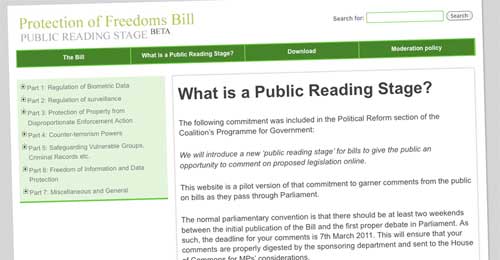
The Protection of Freedoms Bill, published last week, has become the first piece of proposed legislation to go through a ‘public reading stage‘, as promised in the Coalition Agreement. The No10 website says it’s ‘the first step towards meeting the Coalition’s commitment to introduce a public reading stage for all Bills, allowing the Government to test the technology and ensure the system works well.’ And the technology in question is WordPress.
It’s a fairly straightforward presentation, using a custom WordPress theme bearing the catchy name ‘Cabinet Office Commentable Document (non-core)’, produced by the Cabinet Office’s in-house digital team – in double-quick time, so I’m hearing. The government branding is very understated indeed, with only an HM Government logo, in the bottom right corner. It looks like it’s all based on pages, as opposed to posts, with a jQuery-based expand/collapse menu (which I suspect has been hard-coded) in the left margin. It’s sitting on the same Amazon account as the main Cabinet Office site.
Can it work as an idea? I’m not convinced. The commenting technology’s certainly up to it, as we’ve proven time and again. But legislation isn’t exactly written to be read; you don’t have to dig too deeply into the site to find unintelligible passages, with every other sentence cross-referencing another subsection of another chapter of another Act… and no hyperlinking (even though all the source material should presumably be available in legislation.gov.uk). I just can’t imagine how an ordinary member of the public could be expected to make sense of it.
A starting point would be a ‘diff’ tool, similar to a programmer’s code editor – showing the ‘before’ and ‘after’, with changes highlighted. If you’ve never seen one, they look something like this:

… instantly allowing you to see where text has been added and/or changed, and how. Wikipedia offers something similar: if you click on ‘View history’ for any page, you’re able to compare various past versions of the page, and see the changes highlighted (albeit in a less-than-friendly fashion). And indeed, back in 2007 MySociety proposed a diff tool (of sorts) as part of their Free Our Bills campaign.
Without this, I can’t imagine many ordinary people going to the trouble of decoding what’s actually being proposed… meaning I can’t see it doing anything to widen participation, if that’s the intention. So whilst it’ll be useful as a pilot exercise, I fear it’ll only prove the difference between green/white papers, which are text documents intended to be read; and bills, which just aren’t.
Responses
I think it could widen participation, but only narrowly. I don’t think “ordinary people” are really the audience… I think it’s for campaigners and policy nerds. Which is fine.
Failure to properly define the audience is a problem across all public engagement, I think. And there’s an underlying assumption that every engagement opportunity should be for everyone, and that everyone’s opinion has equal value — and I don’t think either are true.
So — if this is only looked at by a few legal geeks and campaigners, that’s fine by me. Hopefully they’ll find some problems which the government will fix, and then we can say it was definitely useful!
Yeah, I suppose it depends what is meant by ‘public’: there’s a big difference between doing something ‘in public’ and doing it ‘for the public’.
Someone mentioned legislation.gov.uk to me yesterday – really good way of showing the evolution of legislation as it is amended through time. Done by TNA.
This thing only launched today, and there are already 100 or so comments. Any indication that the conveners will engage in the comments to answer questions, to acknowledge the input that’s being received and to make sense of it all?
Just to point out that items only make their way to legislation.gov.uk after the Bill has become an Act – after all the Parliament stuff is over and done with. Bills are presented by Parliament rather than The National Archives. Also, I believe there are entirely different systems involved. These points mean it wouldn’t be trivial to move across on the technical side, even if any constitutional issues about draft legislation being published by the executive rather than the legislature were dealt with.
RE who the audience is, the Number 10 press release seems pretty clear that its for the public, not policy geeks…
“The Government believes that traditional consultations on new legislation have been too narrow in focus, often limited to invited experts and specialists, and wants to open up the parliamentary process to the widest possible audience.”
As far as it is possible to tell by the comments left on the site so far, that seems to be the kind of audience it is getting. And there are at least some comments which make interesting points about the wording of the legislation rather than just arguing about the pros and cons of the policies.
I think a lot depends on the legislation. For example, the next bill which changes the way elections are run will have an impact on tens of thousand of volunteer agents and candidates around the country, who have direct experience of how the rules work but who normally are only indirectly or in small numbers involved in consultations over detailed wording. If a process such as this flushes out a few more eyes spotting flaws in wording, it could make a useful impact on the final result.